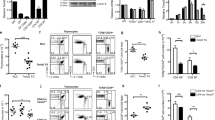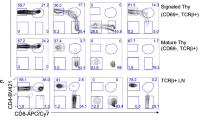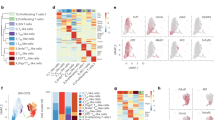Abstract
The mechanism of CD4-CD8 lineage commitment, which ensures the correlation between T cell receptor specificity and adoption of the T killer or T helper phenotype, has long been the subject of intense debate. Various approaches are slowly elucidating the underlying molecular pathways. Analysis of the function of T cell receptor signaling (the 'top-down' approach) supports the view that differences in signal strength and/or duration 'instruct' alternative commitment. Analysis of the transcriptional regulation of the genes encoding CD4 and CD8 (the 'bottom-up' approach) has identified critical cis-acting elements and their interacting factors. Finally, identification of the transcription factor Th-POK as a central component of the CD4 lineage–determining pathway has provided a new starting point from which to unravel this intriguing process 'from the inside out'.
This is a preview of subscription content, access via your institution
Access options
Subscribe to this journal
Receive 12 print issues and online access
$209.00 per year
only $17.42 per issue
Buy this article
- Purchase on Springer Link
- Instant access to full article PDF
Prices may be subject to local taxes which are calculated during checkout





Similar content being viewed by others
References
Suzuki, H., Punt, J.A., Granger, L.G. & Singer, A. Asymmetric signaling requirements for thymocyte commitment to the CD4+ versus CD8+ T cell lineages: a new perspective on thymic commitment and selection. Immunity 2, 413–425 (1995).
Lucas, B. & Germain, R.N. Unexpectedly complex regulation of CD4/CD8 coreceptor expression supports a revised model for CD4+CD8+ thymocyte differentiation. Immunity 5, 461–477 (1996).
Lundberg, K., Heath, W., Kontgen, F., Carbone, F.R. & Shortman, K. Intermediate steps in positive selection: differentiation of CD4+CD8intTCRint thymocytes into CD4−CD8+TCRhi thymocytes. J. Exp. Med. 181, 1643–1651 (1995).
Kydd, R., Lundberg, K., Vremec, D., Harris, A.W. & Shortman, K. Intermediate steps in thymic positive selection: generation of CD4−8+ T cells in culture from CD4+8+,CD4INT8+, and CD4+8INT thymocytes with up-regulated levels of TCR-CD3. J. Immunol. 155, 3806–3814 (1995).
Davis, C.B., Killeen, N., Crooks, M.E., Raulet, D. & Littman, D.R. Evidence for a stochastic mechanism in the differentiation of mature subsets of T lymphocytes. Cell 73, 237–247 (1993).
Chan, S.H., Cosgrove, D., Waltzinger, C., Benoist, C. & Mathis, D. Another view of the selective model of thymocyte selection. Cell 73, 225–236 (1993).
Baron, A., Hafen, K. & von Boehmer, H. A human CD4 transgene rescues CD4−CD8+ cells in 2-microglobulin-deficient mice. Eur. J. Immunol. 24, 1933–1936 (1994).
Itano, A., Kioussis, D. & Robey, E. Stochastic component to development of class I major histocompatibility complex-specific T cells. Proc. Natl. Acad. Sci. USA 91, 220–224 (1994).
Robey, E.A. et al. Thymic selection in CD8 transgenic mice supports an instructive model for commitment to a CD4 or CD8 lineage. Cell 64, 99–107 (1991).
Borgulya, P., Kishi, H., Muller, U., Kirberg, J. & von, B.H. Development of the CD4 and CD8 lineage of T cells: instruction versus selection. EMBO J. 10, 913–918 (1991).
Germain, R.N. T-cell development and the CD4–CD8 lineage decision. Nat. Rev. Immunol. 2, 309–322 (2002).
Matechak, E.O., Killeen, N., Hedrick, S.M. & Fowlkes, B.J. MHC class II-specific T cells can develop in the CD8 lineage when CD4 is absent. Immunity 4, 337–347 (1996).
Veillette, A., Zúñiga-Pflücker, J.C., Bolen, J.B. & Kruisbeek, A.M. Engagement of CD4 and CD8 expressed on immature thymocytes induces activation of intracellular tyrosine phosphorylation pathways. J. Exp. Med. 170, 1671–1680 (1989).
Wiest, D.L. et al. Regulation of T cell receptor expression in immature CD4+CD8+ thymocytes by p56lck tyrosine kinase: basis for differential signaling by CD4 and CD8 in immature thymocytes expressing both coreceptor molecules. J. Exp. Med. 178, 1701–1712 (1993).
Legname, G. et al. Inducible expression of a p56Lck transgene reveals a central role for Lck in the differentiation of CD4 SP thymocytes. Immunity 12, 537–546 (2000).
Hernandez-Hoyos, G., Sohn, S.J., Rothenberg, E.V. & Alberola-Ila, J. Lck activity controls CD4/CD8 T cell lineage commitment. Immunity 12, 313–322 (2000).
Schmedt, C. et al. Csk controls antigen receptor-mediated development and selection of T-lineage cells. Nature 394, 901–904 (1998).
Sharp, L.L., Schwarz, D.A., Bott, C.M., Marshall, C.J. & Hedrick, S.M. The influence of the MAPK pathway on T cell lineage commitment. Immunity 7, 609–618 (1997).
Bommhardt, U., Basson, M.A., Krummrei, U. & Zamoyska, R. Activation of the extracellular signal-related kinase/mitogen-activated protein kinase pathway discriminates CD4 versus CD8 lineage commitment in the thymus. J. Immunol. 163, 715–722 (1999).
Alberola-Ila, J. & Hernández-Hoyos, G. The Ras/MAPK cascade and the control of positive selection. Immunol. Rev. 191, 79–96 (2003).
Yasutomo, K., Doyle, C., Miele, L., Fuchs, C. & Germain, R.N. The duration of antigen receptor signalling determines CD4+ versus CD8+ T-cell lineage fate. Nature 404, 506–510 (2000).
Liu, X. & Bosselut, R. Duration of TCR signaling controls CD4–CD8 lineage differentiation in vivo. Nat. Immunol. 5, 280–288 (2004).
Brugnera, E. et al. Coreceptor reversal in the thymus: signaled CD4+CD8+ thymocytes initially terminate CD8 transcription even when differentiating into CD8+ T cells. Immunity 13, 59–71 (2000).
Chan, S., Correia-Neves, M., Dierich, A., Benoist, C. & Mathis, D. Visualization of CD4/CD8 T cell commitment. J. Exp. Med. 188, 2321–2333 (1998).
Ellmeier, W., Sawada, S. & Littman, D.R. The regulation of CD4 and CD8 coreceptor gene expression during T cell development. Annu. Rev. Immunol. 17, 523–554 (1999).
Hedrick, S.M. T cell development: bottoms-up. Immunity 16, 619–622 (2002).
Sawada, S., Scarborough, J.D., Killeen, N. & Littman, D.R. A lineage-specific transcriptional silencer regulates CD4 gene expression during T lymphocyte development. Cell 77, 917–929 (1994).
Siu, G., Wurster, A.L., Duncan, D.D., Soliman, T.M. & Hedrick, S.M. A transcriptional silencer controls the developmental expression of the CD4. EMBO J. 13, 3570–3579 (1994).
Zou, Y.R. et al. Epigenetic silencing of CD4 in T cells committed to the cytotoxic lineage. Nat. Genet. 29, 332–336 (2001).
Taniuchi, I., Sunshine, M.J., Festenstein, R. & Littman, D.R. Evidence for distinct CD4 silencer functions at different stages of thymocyte differentiation. Mol. Cell 10, 1083–1096 (2002).
Hostert, A. et al. A region in the CD8 gene locus that directs expression to the mature CD8 T cell subset in transgenic mice. Immunity 7, 525–536 (1997).
Ellmeier, W., Sunshine, M.J., Losos, K., Hatam, F. & Littman, D.R. An enhancer that directs lineage-specific expression of CD8 in positively selected thymocytes and mature T cells. Immunity 7, 537–547 (1997).
Ellmeier, W., Sunshine, M.J., Losos, K. & Littman, D.R. Multiple developmental stage-specific enhancers regulate CD8 expression in developing thymocytes and in thymus-independent T cells. Immunity 9, 485–496 (1998).
Hostert, A. et al. Hierarchical interactions of control elements determine CD8A gene expression in subsets of thymocytes and peripheral T cells. Immunity 9, 497–508 (1998).
Ellmeier, W., Sunshine, M.J., Maschek, R. & Littman, D.R. Combined deletion of CD8 locus cis-regulatory elements affects initiation but not maintenance of CD8 expression. Immunity 16, 623–634 (2002).
Taniuchi, I. et al. Differential requirements for Runx proteins in CD4 repression and epigenetic silencing during T lymphocyte development. Cell 111, 621–633 (2002).
Woolf, E. et al. Runx3 and Runx1 are required for CD8 T cell development during thymopoiesis. Proc. Natl. Acad. Sci. USA 100, 7731–7736 (2003).
Sato, T. et al. Dual functions of Runx proteins for reactivating CD8 and silencing CD4 at the commitment process into CD8 thymocytes. Immunity 22, 317–328 (2005).
Ehlers, M. et al. Morpholino antisense oligonucleotide-mediated gene knockdown during thymocyte development reveals role for Runx3 transcription factor in CD4 silencing during development of CD4−CD8+ thymocytes. J. Immunol. 171, 3594–3604 (2003).
Telfer, J.C., Hedblom, E.E., Anderson, M.K., Laurent, M.N. & Rothenberg, E.V. Localization of the domains in Runx transcription factors required for the repression of CD4 in thymocytes. J. Immunol. 172, 4359–4370 (2004).
Kitabayashi, I., Yokoyama, A., Shimizu, K. & Ohki, M. Interaction and functional cooperation of the leukemia-associated factors AML1 and p300 in myeloid cell differentiation. EMBO J. 17, 2994–3004 (1998).
Westendorf, J.J. et al. Runx2 (Cbfa1, AML-3) interacts with histone deacetylase 6 and represses the p21CIP1/WAF1 promoter. Mol. Cell. Biol. 22, 7982–7992 (2002).
Levanon, D. et al. Transcriptional repression by AML1 and LEF-1 is mediated by the TLE/Groucho corepressors. Proc. Natl. Acad. Sci. USA 95, 11590–11595 (1998).
Lutterbach, B. et al. A mechanism of repression by acute myeloid leukemia-1, the target of multiple chromosomal translocations in acute leukemia. J. Biol. Chem. 275, 651–656 (2000).
Hayashi, K. et al. Overexpression of AML1 transcription factor drives thymocytes into the CD8 single-positive lineage. J. Immunol. 167, 4957–4965 (2001).
Kohu, K. et al. Overexpression of the Runx3 transcription factor increases the proportion of mature thymocytes of the CD8 single-positive lineage. J. Immunol. 174, 2627–2636 (2005).
Tyznik, A.J., Sun, J.C. & Bevan, M.J. The CD8 population in CD4-deficient mice is heavily contaminated with MHC class II-restricted T cells. J. Exp. Med. 199, 559–565 (2004).
Chi, T.H. et al. Reciprocal regulation of CD4/CD8 expression by SWI/SNF-like BAF complexes. Nature 418, 195–199 (2002).
Chi, T.H. et al. Sequential roles of Brg, the ATPase subunit of BAF chromatin remodeling complexes, in thymocyte development. Immunity 19, 169–182 (2003).
Brown, K.E., Baxter, J., Graf, D., Merkenschlager, M. & Fisher, A.G. Dynamic repositioning of genes in the nucleus of lymphocytes preparing for cell division. Mol. Cell 3, 207–217 (1999).
Merkenschlager, M., Amoils, S., Roldan, E. & Rahemtulla, A., O'connor, E., Fisher, A.G. & Brown, K.E. Centromeric repositioning of coreceptor loci predicts their stable silencing and the CD4/CD8 lineage choice. J. Exp. Med. 200, 1437–1444 (2004).
Delaire, S., Huang, Y.H., Chan, S.W. & Robey, E.A. Dynamic repositioning of CD4 and CD8 genes during T cell development. J. Exp. Med. 200, 1427–1435 (2004).
Cobb, B.S. et al. Targeting of Ikaros to pericentromeric heterochromatin by direct DNA binding. Genes Dev. 14, 2146–2160 (2000).
Harker, N. et al. The CD8α gene locus is regulated by the Ikaros family of proteins. Mol. Cell 10, 1403–1415 (2002).
Brown K.E. et al. Association of transcriptionally silent genes with Ikaros complexes at centromeric heterochromatin. Cell 91, 845–854 (1997).
Kim, J. et al. Ikaros DNA-binding proteins direct formation of chromatin remodeling complexes in lymphocytes. Immunity 10, 345–355 (1999).
He, X. et al. The zinc finger transcription factor Th-POK regulates CD4 versus CD8 T-cell lineage commitment. Nature 433, 826–833 (2005).
Sun, G. et al. The zinc finger protein cKrox directs CD4 lineage differentiation during intrathymic T cell positive selection. Nat. Immunol. 6, 373–381 (2005).
Dave, V.P., Allman, D., Keefe, R., Hardy, R.R. & Kappes, D.J. HD mice: a novel mouse mutant with a specific defect in the generation of CD4+ T cells. Proc. Natl. Acad. Sci. USA 95, 8187–8192 (1998).
Keefe, R., Dave, V., Allman, D., Wiest, D. & Kappes, D.J. Regulation of lineage commitment distinct from positive selection. Science 286, 1149–1153 (1999).
Hashimoto, K. et al. Requirement for p56lck tyrosine kinase activation in T cell receptor-mediated thymic selection. J. Exp. Med. 184, 931–943 (1996).
Hernandez-Hoyos, G., Anderson, M.K., Wang, C., Rothenberg, E.V. & Alberola-Ila, J. GATA-3 expression is controlled by TCR signals and regulates CD4/CD8 differentiation. Immunity 19, 83–94 (2003).
Bhandoola, A., Kithiganahalli, B., Granger, L. & Singer, A. Programming for cytotoxic effector function occurs concomitantly with CD4 extinction during CD8+ T cell differentiation in the thymus. Int. Immunol. 12, 1035–1040 (2000).
Melnick, A. et al. Critical residues within the BTB domain of PLZF and Bcl-6 modulate interaction with corepressors. Mol. Cell. Biol. 22, 1804–1818 (2002).
Galera, P., Musso, M., Ducy, P. & Karsenty, G. c-Krox, a transcriptional regulator of type I collagen gene expression, is preferentially expressed in skin. Proc. Natl. Acad. Sci. USA 91, 9372–9376 (1994).
Widom, R.L., Culic, I., Lee, J.Y. & Korn, J.H. Cloning and characterization of hcKrox, a transcriptional regulator of extracellular matrix gene expression. Gene 198, 407–420 (1997).
Nawijn, M.C. et al. Enforced expression of GATA-3 during T cell development inhibits maturation of CD8 single-positive cells and induces thymic lymphoma in transgenic mice. J. Immunol. 167, 715–723 (2001).
Pai, S.Y. et al. Critical roles for transcription factor GATA-3 in thymocyte development. Immunity 19, 863–875 (2003).
Komine, O. et al. The Runx1 transcription factor inhibits the differentiation of naive CD4+ T cells into the Th2 lineage by repressing GATA3 expression. J. Exp. Med. 198, 51–61 (2003).
Robey, E. et al. An activated form of Notch influences the choice between CD4 and CD8 T cell lineages. Cell 87, 483–492 (1996).
Fowlkes, B.J. & Robey, E.A. A reassessment of the effect of activated Notch1 on CD4 and CD8 T cell development. J. Immunol. 169, 1817–1821 (2002).
Wilkinson, B. et al. TOX: an HMG box protein implicated in the regulation of thymocyte selection. Nat. Immunol. 3, 272–280 (2002).
Aliahmad, P. et al. TOX provides a link between calcineurin activation and CD8 lineage commitment. J. Exp. Med. 199, 1089–1099 (2004).
Robey, E.A. & Bluestone, J.A. Notch signaling in lymphocyte development and function. Curr. Opin. Immunol. 16, 360–366 (2004).
Saito, T. et al. Notch2 is preferentially expressed in mature B cells and indispensable for marginal zone B lineage development. Immunity 18, 675–685 (2003).
Wolfer, A. et al. Inactivation of Notch 1 in immature thymocytes does not perturb CD4 or CD8T cell development. Nat. Immunol. 2, 235–241 (2001).
Tanigaki, K. et al. Regulation of αβ/gγδ T cell lineage commitment and peripheral T cell responses by Notch/RBP-J signaling. Immunity 20, 611–622 (2004).
Acknowledgements
We thank the colleagues whose work could not be cited because of space constraints. Supported by the National Institutes of Health (D.J.K.) and the Commonwealth of Pennsylvania.
Author information
Authors and Affiliations
Corresponding author
Ethics declarations
Competing interests
The authors declare no competing financial interests.
Rights and permissions
About this article
Cite this article
Kappes, D., He, X. & He, X. CD4-CD8 lineage commitment: an inside view. Nat Immunol 6, 761–766 (2005). https://doi.org/10.1038/ni1230
Published:
Issue Date:
DOI: https://doi.org/10.1038/ni1230
This article is cited by
-
Twist2 promotes CD8+ T-cell differentiation by repressing ThPOK expression
Cell Death & Differentiation (2020)
-
Effect of Metal-Containing Nanocomposites on Functional Status of the Thymus in Experimental Animals
Bulletin of Experimental Biology and Medicine (2017)
-
The Nuclear Receptor Nr4a1 Controls CD8 T Cell Development Through Transcriptional Suppression of Runx3
Scientific Reports (2015)
-
Themis is a member of a new metazoan gene family and is required for the completion of thymocyte positive selection
Nature Immunology (2009)
-
ThPOK acts late in specification of the helper T cell lineage and suppresses Runx-mediated commitment to the cytotoxic T cell lineage
Nature Immunology (2008)



